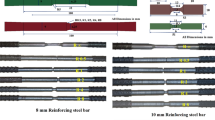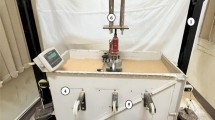Abstract
Innovative composite shear walls (ICSW) with multi-partition steel tubes and concrete have been increasingly used for improving seismic performance in engineering structures. However, limited research has focused on the interface bond behavior between steel tubes and concrete. This study aimed to investigate experimentally the bond performance through seven ICSW specimens subjected to push-out tests. The influences of the effective width-to-thickness ratio and adjacent cavity restriction conditions on the bond strength are discussed. It was found that the bond strength increased with a decrease in the effective width-to-thickness ratio of the steel tubes, and the adjacent cavity restriction condition had a slight influence on the bond strength. To determine peak bond strength, the simplified calculation formulas that considered the influence of the effective width-to-thickness ratio were developed. A theoretical bond-slip model for predicting the bond-slip behavior of multi-partition steel tubes and concrete was proposed, which was verified to be acceptable by comparison with the test results. The present study could provide the valuable data for engineering applications of ICSW structures.












Similar content being viewed by others
References
Greifenhagen C, Lestuzzi P (2005) Static cyclic tests on lightly reinforced concrete shear walls. Eng Struct 27(11):1703–1712. https://doi.org/10.1016/j.engstruct.2005.06.008
Dan D, Fabian A, Stoian V (2011) Nonlinear behavior of composite shear walls with vertical steel encased profiles. Eng Struct 33(10):2794–2804. https://doi.org/10.1016/j.engstruct.2011.06.004
Stephens MJ, Zimmerman TJE (1990) The strength of composite ice-resisting walls subjected to combined loads. In: Proc., 1st European Offshore Mechanics Symp. (EUROMS-90), Golden, CO: International Society of Offshore and Polar Engineers
Link RA, Elwi AE (1995) Composite concrete-steel plate walls: analysis and behavior. J Struct Eng 121(2):260–271. https://doi.org/10.1061/(ASCE)0733-9445(1995)121:2(260)
Clubley SK, Moy SSJ, Xiao RY (2003) Shear strength of steel–concrete–steel composite panels. Part I—testing and numerical modelling. J Constr Steel Res 59(6):781–794. https://doi.org/10.1016/S0143-974X(02)00061-5
Ozaki M, Akita S, Osuga H, Nakayama T, Adachi N (2004) Study on steel plate reinforced concrete panels subjected to cyclic in-plane shear. Nucl Eng Des 228(1–3):225–244. https://doi.org/10.1016/j.nucengdes.2003.06.010
Huang Z, Liew JYR (2016) Structural behaviour of steel-concrete-steel sandwich composite wall subjected to compression and end moment. Thin Walled Struct 98:592–606. https://doi.org/10.1016/j.tws.2015.10.013
Ji X, Cheng X, Jia X, Varma AH (2017) Cyclic in-plane shear behavior of double-skin composite walls in high-rise buildings. J Struct Eng 143(6):04017025. https://doi.org/10.1061/(ASCE)ST.1943-541X.0001749
Chen L, Song B, Zhou L, Zhou A (2021) Experimental study and numerical simulation on seismic behavior of double-skin composite wall. J Constr Steel Res 187:106935. https://doi.org/10.1016/j.jcsr.2021.106935
Guo Y, Zhu J, Wang M, Yang X, Zhou P (2018) Overall instability performance of concrete-infilled double steel corrugated-plate wall. Thin Wall Struct 130:372–394. https://doi.org/10.1016/j.tws.2018.05.026
Zhao Q, Li Y, Tian Y, Li Z (2020) Cyclic behavior of corrugated double-skin composite walls with different aspect ratios. J Struct Eng 146(10):04020214. https://doi.org/10.1061/(ASCE)ST.1943-541X.0002783
Wang Y, Guo L, Li H (2021) L-shaped steel-concrete composite columns under axial load: experiment, simulations and design method. J Constr Steel Res 185:106871. https://doi.org/10.1016/j.jcsr.2021.106871
Zhang X, Qin Y, Chen ZH (2016) Experimental seismic behavior of innovative composite shear walls. J Constr Steel Res 116:218–232. https://doi.org/10.1016/j.jcsr.2015.09.015
Guo L, Wang Y, Zhang S (2018) Experimental study of rectangular multi-partition steel-concrete composite shear walls. Thin walled Struct 130:577–592. https://doi.org/10.1016/j.tws.2018.06.011
Wang Y, Guo L, Li H, Fu F (2022) Axial and hysteretic behavior of T-shaped steel-concrete composite shear walls. Structures 38:279–291. https://doi.org/10.1016/j.istruc.2022.01.091
Sakino K, Nakahara H, Morino S (2004) Behavior of centrally loaded concrete-filled steel-tube short columns. J Struct Eng 130(2):180–188. https://doi.org/10.1061/(ASCE)0733-9445(2004)130:2(180)
Virdi KS, Dowling PJ (1975) Bond strength in concrete filled circular steel tubes. Composite columns. CESLIC Report. CC11. Engineering Structures Laboratories, Civil Engineering Department, Imperial College, London
Morishita Y, Tomii M, Yoshimura K (1979) Experimental studies on bond strength in concrete filled circular steel tubular columns subjected to axial loads. Trans Jpn Concr Inst 1:351–358
Roeder CW, Cameron B, Brown CB (1999) Composite action in concrete filled tubes. J Struct Eng 125(5):477–484. https://doi.org/10.1061/(ASCE)0733-9445(1999)125:5(477)
Chang X, Huang CK, Jiang DC, Song YC (2009) Push-out test of pre-stressing concrete filled circular steel tube columns by means of expansive cement. Constr Build Mater 23(1):491–497. https://doi.org/10.1016/j.conbuildmat.2007.10.021
Aly T, Elchalakani M, Thayalan P, Patnaikuni I (2010) Incremental collapse threshold for pushout resistance of circular concrete filled steel tubular columns. J Constr Steel Res 66(1):11–18. https://doi.org/10.1016/j.jcsr.2009.08.002
Tao Z, Han LH, Uy B, Chen X (2011) Post-fire bond between the steel tube and concrete in concrete-filled steel tubular columns. J Constr Steel Res 67(3):484–496. https://doi.org/10.1016/j.jcsr.2010.09.006
Qu XS, Chen ZH, Nethercot DA, Gardner L, Theofanous M (2013) Load-reversed push-out tests on rectangular CFST columns. J Constr Steel Res 81:35–43. https://doi.org/10.1016/j.jcsr.2012.11.003
Chen Y, Feng R, Shao YB, Zhang XT (2017) Bond-slip behaviour of concrete-filled stainless steel circular hollow section tubes. J Constr Steel Res 130:248–263. https://doi.org/10.1016/j.jcsr.2016.12.012
Feng R, Chen Y, He K, Wei JG, Chen BC, Zhang XT (2018) Push-out tests of concrete-filled stainless steel SHS tubes. J Constr Steel Res 145:58–69. https://doi.org/10.1016/j.jcsr.2018.02.016
Mirza SA, Lacroix EA (2004) Comparative strength analyses of concrete-encased steel composite columns. J Struct Eng 130(12):1941–1953. https://doi.org/10.1061/(ASCE)0733-9445(2004)130:12(1941)
Acknowledgements
The financial supports of the National Natural Science Foundation of China (Grant No. 52078319) and Postgraduate Research & Innovation Program of Jiangsu Province (KYCX21-3033) are gratefully acknowledged.
Author information
Authors and Affiliations
Corresponding author
Ethics declarations
Conflict of interest
The authors declare that they have no conflict of interest.
Additional information
Publisher's Note
Springer Nature remains neutral with regard to jurisdictional claims in published maps and institutional affiliations.
Rights and permissions
Springer Nature or its licensor (e.g. a society or other partner) holds exclusive rights to this article under a publishing agreement with the author(s) or other rightsholder(s); author self-archiving of the accepted manuscript version of this article is solely governed by the terms of such publishing agreement and applicable law.
About this article
Cite this article
Sun, G., Yang, K. Bond-slip behavior between multi-partition steel tubes and concrete. Mater Struct 56, 63 (2023). https://doi.org/10.1617/s11527-023-02155-3
Received:
Accepted:
Published:
DOI: https://doi.org/10.1617/s11527-023-02155-3




